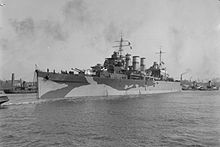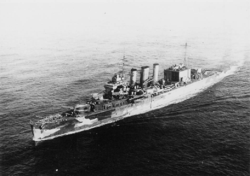HMS Suffolk (55)
|
HMS Suffolk , 1941
|
||||||||||||||||||||
|
||||||||||||||||||||
|
||||||||||||||||||||
|
||||||||||||||||||||
|
||||||||||||||||||||
The HMS Suffolk was a heavy cruiser of the Kent class of the Royal Navy , mainly in the Second World War was used before him abwrackte 1948th
history
Planning and construction
The Suffolk was laid down on November 30, 1924 in Portsmouth Dockyard as a county class cruiser. She was part of the first batch of this class, which showed some differences to the ships built later. Accordingly, this first construction lot is often referred to as a separate subgroup with the Kent class.
The heavy cruisers were developed under the restrictions of the Washington Fleet Treaty of 1922 and should be worth 10,000 tons. When loaded, the water displacement should not exceed the standard displacement .
The Suffolk was launched on February 16, 1926 and entered service two years later. She was the sixth ship in the Royal Navy to bear that name. The ship's motto was Nous Maintaindrons (German: we preserve ).
China
The Suffolk was assigned three times to the "China Fleet" of the Royal Navy for about two years each time. During this time, in 1932, she received an aircraft catapult on the superstructure, immediately aft of the rear funnel. A Fairey Flycatcher aircraft or, from 1934, a Hawker Osprey could be launched with the catapult. However, there was no hangar for the aircraft.
After the death of the Japanese admiral Tōgō in June 1934, she promoted Admiral Fredric Dreyer to Yokohama to attend the funeral.
The heavy cruiser under the command of Captain Errol Manners was stationed in Hong Kong as the flagship of the "China Fleet" . In October 1934, the Suffolk suffered while trying to support the distressed merchant ship City of Cambridge of the Ellerman Lines , due to heavy seas, light damage to its superstructure. The freighter had been thrown from the sea onto the Pratas Reef in the storm and lay with the entire keel, the propeller and rudder above the water. 104 crew members of the freighter were transferred by boat to Suffolk , which was in heavy seas next to the reef. The command of the Suffolk ended on March 29, 1935.
After their return, the ship was docked for overhaul.
modernization
From 1935 on, extensive modifications were made to compensate for construction weaknesses in the ship class on the one hand and to upgrade the ship to a modern standard on the other. A hangar was set up between the aircraft catapult and tower "C" and the catapult itself was replaced by a new version. The ship could now deploy two Walrus reconnaissance aircraft.
An approximately 10 cm thick belt armor made of case-hardened steel was drawn in along the length of the engine rooms at the level of the waterline on the sides of the hull, and the aft deck from tower "D" to the stern was lowered by one deck.
A single water bomb dropping rack was placed on the deck at the stern. The heavy 10.2 cm L / 45 anti-aircraft guns were enclosed with a protective shield that was open to the rear.
Beginning of the Second World War
In October 1939, about a month after hostilities broke out, Suffolk received a pre-production model of the 79Z radar on a tripod mast and the lower edge of the bow was modified. The radar had an output of up to 70 kW and was developed to detect aerial targets; under optimal conditions, it could locate an aircraft up to 100 kilometers away.
The Suffolk was initially relocated to the Mediterranean , but was recalled in November 1939 and used from Scapa Flow to patrol the North Sea . On February 2, 1940, she collided with the cargo ship Misram and had to call at a shipyard for repairs. She returned in early April and landed Royal Marines soldiers in the Faroe Islands on April 13 as part of Operation Valentine .
Operation Duck
She was then assigned with four destroyers to bombard an airfield that German troops had occupied near Stavanger in Norway on April 9th. On April 17, 1940, the cruiser used its two reconnaissance aircraft - on the one hand to spy on the airfield and on the other hand to send correction data to its own artillery during the bombardment. Disturbed by poor visibility, many of the 202 shells that the Suffolk fired with its 20.3 cm main artillery in the early morning of April 17 were not on the area of the airfield about 18,000 meters away, but in the area of one Seaplane base. Four He 115 Cs and one He-59 seaplane were destroyed.
To intercept a group of German destroyers that had been reported north by a British scout, the Suffolk was withdrawn from the bombardment and sent in the direction of this new enemy. The British association was now initially the target of air strikes by He-111 bombers of the German Air Force. The hunting protection that the Royal Air Force was supposed to provide for the ships, however, did not find the British ship association, but became involved in aerial battles near the German airfield and ultimately withdrew. So the Suffolk commander decided to break off the mission and run to Scapa Flow.
More than 80 aerial bombs missed their target, but one dropped by a Ju 88A of Kampfgeschwader 30 hit near tower "C" of the cruiser. It broke through several decks before exploding between one of the engine rooms and the tower's propellant magazine. The stored cordite ignited and a flame shot through the tower and engine room. Both aft main turrets failed and water penetrating made the engine room unusable, so that the speed dropped to 18 knots. 32 crew members died. Further close hits by bombs punched holes in the ship's sides and tore off sea seals, which caused further flooding, so that the aft ship was completely full.
With the aft deck already partially flooded by the sea, the heavy cruiser reached Scapa Flow on the 18th and then had to be docked for repairs by December.
During the repair, the ship also received a new Type 274 radar on the roof of the bridge. The device was designed to search for targets on the surface of the water, had an output of 400 kW and had a range of around 30 kilometers.
Bismarck

In 1941 the Suffolk was part of Rear Admiral Frederic Wake-Walker's 1st Cruiser Squadron . Together with her sister ship HMS Norfolk , on which the Rear Admiral had embarked, she was assigned to patrol duty in the Denmark Strait . The Suffolk was supposed to monitor the northern part of the strait because of its better radar equipment, where the disruption from drift ice was greater, while her sister ship was closer to Iceland . Although the Suffolk could theoretically locate large ships at a distance of up to 30 km with her radar, her radar was mounted in an inconvenient position where interference from the superstructure of the ship created a blind spot on the aft. It was a seaman with binoculars who discovered the German battleship Bismarck and the heavy cruiser Prinz Eugen on the evening of May 23, 1941 , when they were only 13 kilometers away from the British cruiser. Captain Ellis immediately ordered the Suffolk to be steered into a bank of fog to avoid possible attack.
The Suffolk sat behind the German ships and now followed them with her radar, careful to stay out of range of the long-range enemy guns. The position information that was transmitted to the British Admiralty from the Suffolk to bring in strong combat units could be received and decoded on the German ships.
The battle cruiser HMS Hood and the battleship HMS Prince of Wales were supposed to intercept the German unit based on the position reports from the Suffolk . However, the radar operators on board the Suffolk lost the German ships for an hour and a half in a snow storm, so that the heavy British ships had to approach the enemy without exact information about its position and course and the original attack plan was no longer feasible. In the following battle in the Denmark Strait , the Hood was sunk and the Suffolk forced to turn for a short time. The German commander, Admiral Günther Lütjens , used this moment and ordered Prince Eugene to leave without being noticed.
North Sea and renewed modernization

The Suffolk contributed to the sinking of the Bismarck continue their service in the North Sea. She was part of several security groups of northern sea convoys and accompanied British aircraft carriers on their missions against targets in Norway.
It was again equipped with new radars in mid-1942. A type 279 for surface search was placed on the roof of the hangar and a type 281 antenna for air search was placed on both mast tips. At the beginning of 1943, these systems were supplemented by a type 282 fire control radar for air defense.
The roof of the bridge was armored and the air defense system was expanded to include six 20 mm L / 70 Oerlikon automatic cannons . The aircraft catapult was removed from the ship, but the structure with the aircraft hangar was retained.
Pacific
In May 1943 the Suffolk moved to the Pacific . She was there primarily used to secure the Allied aircraft carrier fleets and performed escort duties for cargo ships and tankers.
After an overhaul in Durban , it was involved in the bombardment of the Japanese garrison on the Nicobar Islands , Operation Millet , in October 1944 and subsequently attacked Japanese facilities on Sumatra .
The End
On July 6, 1945 she was ordered back and used in the following years to transport troops. These missions ended in April 1946. The ship was laid up in Chatham until it was sold for scrapping in 1948. The scrapping was completed in January 1949.
literature
- Niklas Zetterling, Michael Tamelander: Bismarck: The Final Days of Germany's Greatest Battleship: A Minute-by-minute Account of the Final Hours of Germany's Greatest Battleship. Casemate publishing, 2009, ISBN 978-1935149040 (English).
- Chris Mills: Beyond The Harbor Lights. Whittles Publishing, 2003, ISBN 978-1870325646 (English).
Web links
- HMS Suffolk on www.world-war.co.uk (engl.)
- Motion profile of Suffolk on naval-history.net (Engl.)
- Gerhard Hepcke: THE RADAR WAR , PDF (engl.)
Footnotes
- ↑ a b c d e HMS Suffolk at www.world-war.co.uk, viewed July 10, 2012
- ↑ a b Chris Mills: Beyond The Harbor Lights. P. 33.
- ↑ a b Chris Mills: Beyond The Harbor Lights. Pp. 36, 37.
- ^ British Documents on Foreign Affairs: Reports and Papers from the Foreign Office Confidential Print. University Publications of America, 1991, ISBN 0890936129 , p. 370.
- ^ Gerhard Hepcke: THE RADAR WAR. P. 6.
- ↑ a b c Eric Schwarz: Operation Duck , viewed July 22, 2012
- ↑ 274 Radar at pwencycl.kgbudge.com, viewed July 15, 2012
- ↑ Niklas Zetterling, Michael Tamelander: Bismarck: The Final Days of Germany's Greatest Battleship: A Minute-by-minute Account of the Final Hours of Germany's Greatest Battleship. Pp. 145, 146.
- ↑ Niklas Zetterling, Michael Tamelander: Bismarck: The Final Days of Germany's Greatest Battleship: A Minute-by-minute Account of the Final Hours of Germany's Greatest Battleship. P. 147.
- ↑ Niklas Zetterling, Michael Tamelander: Bismarck: The Final Days of Germany's Greatest Battleship: A Minute-by-minute Account of the Final Hours of Germany's Greatest Battleship. P. 161 and following.
